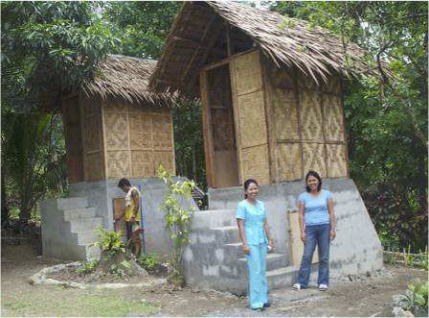Difference between revisions of "3R (sanitation) – Reduce, Reuse, Recycle of waste"
(Published from sandbox) |
(No difference)
|
Revision as of 00:27, 16 November 2013

| Reduce - to use less. Incorporates common sense ideas like turning off the lights, using rain barrels, and taking shorter showers, but also plays a part in composting, and low-flow or compostable toilets.
Reuse - elements of the discarded item are used again. Initiatives include waste exchange and composting (nutrients). Includes the terms repair, regift, and upcycle. Safe collection, storage, treatment and disposal (re-use or recycling) of human excreta. Management (re-use or recycling) of solid waste (rubbish). Drainage and disposal (re-use or recycling) of household waste water... also referred to as grey water. Recycle - discards are separated into materials that may be incorporated into new products. This is different from reuse in that energy is used to change the physical properties of the material. Initiatives include composting, construction materials recycling. Within recycling there is distinction between two types:
|
Sustainable sanitation

The main objective of a sanitation system is to protect and promote human health by providing a clean environment and breaking the cycle of disease. In order to be sustainable, a sanitation system has to be not only economically viable, socially acceptable, and technically and institutionally appropriate, it should also protect the environment and the natural resources.
When improving an existing and/or designing a new sanitation system, sustainability criteria using the 3R method should be considered:
Health and hygiene: includes the risk of exposure to pathogens and hazardous substances that could affect public health at all points of the sanitation system from the toilet via the collection and treatment system to the point of reuse or disposal and downstream populations. This topic also covers aspects such as hygiene, nutrition and improvement of livelihood achieved by the application of a certain sanitation system, as well as downstream effects.
Environment and natural resources: involves the required energy, water and other natural resources for construction, operation and maintenance of the system, as well as the potential emissions to the environment resulting from its use. It also includes the degree of recycling and reuse practiced and the effects of these (e.g. reusing wastewater; returning nutrients and organic material to agriculture), and the protection of other non-renewable resources, e.g. through the production of renewable energies (such as biogas).
Technology and operation: incorporates the functionality and the ease with which the entire system including the collection, transport, treatment and reuse and/or final disposal can be constructed, operated and monitored by the local community and/or the technical teams of the local utilities. Furthermore, the robustness of the system, its vulnerability towards power cuts, water shortages, floods, earthquakes etc. and the flexibility and adaptability of its technical elements to the existing infrastructure and to demographic and socio-economic developments are important aspects.
Financial and economic issues: relate to the capacity of households and communities to pay for sanitation, including the construction, operation, maintenance and necessary reinvestments in the system. Besides the evaluation of these direct costs also direct benefits e.g. from recycled products (soil conditioner, fertiliser, energy and reclaimed water) and external costs and benefits have to be taken into account. Such external costs are e.g. environmental pollution and health hazards, while benefits include increased agricultural productivity and subsistence economy, employment creation, improved health and reduced environmental risks.
Socio-cultural and institutional aspects: the criteria in this category refer to the socio-cultural acceptance and appropriateness of the system, convenience, system perceptions, gender issues and impacts on human dignity, the contribution to food security, compliance with the legal framework and stable and efficient institutional settings.
Most sanitation systems have been designed with these aspects in mind, but in practice they fail far too often because some of the criteria are not met. In fact, there is probably no system which is absolutely sustainable. The concept of sustainability is more of a direction rather than a stage to reach. Nevertheless, it is crucial, that sanitation systems are evaluated carefully with regard to all dimensions of sustainability. Since there is no one-for-all sanitation solution which fulfils the sustainability criteria in different circumstances to the same extent, this system evaluation will depend on the local framework and has to take into consideration existing environmental, technical, socio-cultural and economic conditions.
Possible measures for a recycling strategy: composting toilets
Urine diversion composting toilet
Combining the decentralisation approach with users’ perceptions, demands and local conditions, five possible solutions may be chosen.
- The owners of dehydration or composting units are responsible for reusing the products. How to handle the material is everyone’s own decision.
- Reuse of the material is the responsibility of the Town Council. A public company has to collect the sanitised products, has to guarantee a sufficient secondary treatment and has to recycle the material.
- Emptying the chambers becomes a private business, which should be self-sustaining.
- Farmers, who are interested in reusing sanitised human faeces as manure, are collecting the material from the units.
- The owners of a toilet are selling the products to farmers.
Field experiences
| Akvo RSR Project: Eau Hygiène et Assainissement
The project is carried out with the construction of a row of six ecosan latrines, using manual drilling. It is located close to the market to serve Sirakorola fairground and the rural community. The latrine is equipped with a device that separates urine and feces to be collected to fertilize fields after a period of sterilization for 6 to 8 months. The water of canal cleaning is drained to irrigate a garden. Training courses are organized. |
3R & sustainable sanitation links
- Large-scale peri-urban and rural sanitation with UDDTs, South Western region, Uganda. Sustainable Sanitation Alliance, 2012.
- Reuse of human urine in aquaculture Kalyani, West Bengal, India. Sustainable Sanitation Alliance (SuSanA), 2010.
- Pour-flush toilets with biogas plant at DSK Training Institute, Gujarat, India - Draft. Sustainable Sanitation Alliance (SuSanA), 2009.
- Greywater tower Arba Minch, Ethiopia. Sustainable Sanitation Alliance (SuSanA), 2010.
- Wastewater treatment using constructed wetlands Tirana, Albania. Sustainable Sanitation Alliance (SuSanA), 2012.
- Sanitation and hygiene in developing countries: A case study from Burkina Faso identifying and responding to barriers. February 2007
- Reuse.Reduce.Recycle. Ecosan.at
Acknowledgements
- What is sustainable sanitation? Sustainable Sanitation Alliance.
- Waste hierarchy. Wikipedia.

